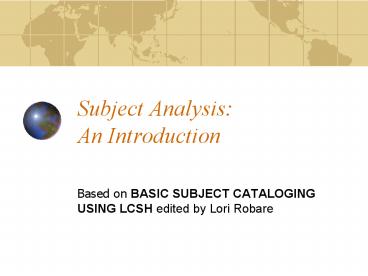Subject Analysis: An Introduction - PowerPoint PPT Presentation
1 / 16
Title:
Subject Analysis: An Introduction
Description:
Subject analysis is the part of indexing or cataloging that deals with the ... 'syndetic structure' Function of keywords. Advantages: ... – PowerPoint PPT presentation
Number of Views:67
Avg rating:3.0/5.0
Title: Subject Analysis: An Introduction
1
Subject AnalysisAn Introduction
- Based on BASIC SUBJECT CATALOGING USING LCSH
edited by Lori Robare
2
Subject analysis principles
- What are the basic principles of subject
analysis? - How do you determine what an item is about?
- Why do controlled vocabularies help in providing
subject access?
3
Definitions
- Subject analysis is the part of indexing or
cataloging that deals with the conceptual
analysis of an item - what is it about? what is its form/genre/format?
- translates that analysis into a particular
subject heading system - 1st step in classification
- Subject heading a term or phrase used in a
subject heading list to represent a concept,
event, or name
4
Definitions (cont.)
- Classification
- Process of organizing resources by assigning an
alphanumerical string that sorts physical objects
by subject
5
Analysis vs. indexing
- Analysis
- Look at the work as a whole to determine its
overall contents - Think of terms that summarize the primary subject
focus of the work - Indexing
- Provide in-depth access to parts of items
(chapters, articles, detailed listing of topics)
6
Determining the subject contentExamine the
subject-rich portions of the item being cataloged
to identify key words and concepts
- Abstract or summary
- Index
- Illustrations, diagrams
- Containers
- Title
- Table of contents
- Introduction or preface
- Authors purpose or forward
7
Types of concepts to identify
- Topics
- Names of
- Persons
- Corporate bodies
- Geographic areas
- Time periods
- Titles of works
- Form of the item
8
Subjects vs. forms/genres
- Subject what the item is about
- Form what the item is, rather than what it is
about - Physical character (video, map, miniature book)
- Type of data it contains (statistics)
- Arrangement of information (diaries, indexes)
- Style, technique (drama, romances)
- Genre works with common theme, setting, etc.
- Mystery fiction Comedy films
9
Important factors Objectivity
- Catalogers must give an accurate, unbiased
indication of the contents of an item - Assess the topic objectively, remain openminded
- Consider the authors intent and the audience
- Avoid personal value judgments
- Give equal attention to works, including
- Topics you might consider frivolous
- Works with which you dont agree
10
Examples Exercising objectivity
- The big lie the Pentagon plane crash that never
happened / Thierry Meyssan. - Dawn the herald of a new and better day.
- The silent subject reflections on the unborn in
American culture / edited by Brad Stetson.
11
Important factors Catalogersjudgment
- Individual perspective
- Informed by the catalogers background knowledge
of the subject - Informed by the catalogers cultural background
- Consistency in determining What is it about?
leads to greater consistency in assignment of
subject headings
12
Translating key words concepts into subject
headings
- Controlled vocabulary
- Thesauri (examples)
- Art Architecture Thesaurus (AAT)
- Thesaurus of ERIC Descriptors
- Subject heading lists (examples)
- Library of Congress Subject Headings
- Sears List of Subject Headings
- Medical Subject Headings (MeSH)
13
Why use controlled vocabulary?
- Controlled vocabularies
- identify a preferred way of expressing a concept
- allow for multiple entry points (i.e.,
cross-references) leading to the preferred term - identify a terms relationship to broader,
narrower, and related terms - syndetic structure
14
Function of keywords
- Advantages
- provide access to the words used in bibliographic
records - Disadvantages
- cannot compensate for complexities of language
and expression - cannot compensate for context
- Keyword searching is enhanced by assignment of
controlled vocabulary!
15
Exampleskeyword searching challenges
- Above all, dont flush! adventures in valorous
living. - Lets rejoin the human race!
- Dawn the herald of a new and better day.
- Phantom limb
16
Exercises
- Read through the following materials and
determine the subject content of each work. - Create a list of key words and concepts that
would be translated into a controlled vocabulary.































